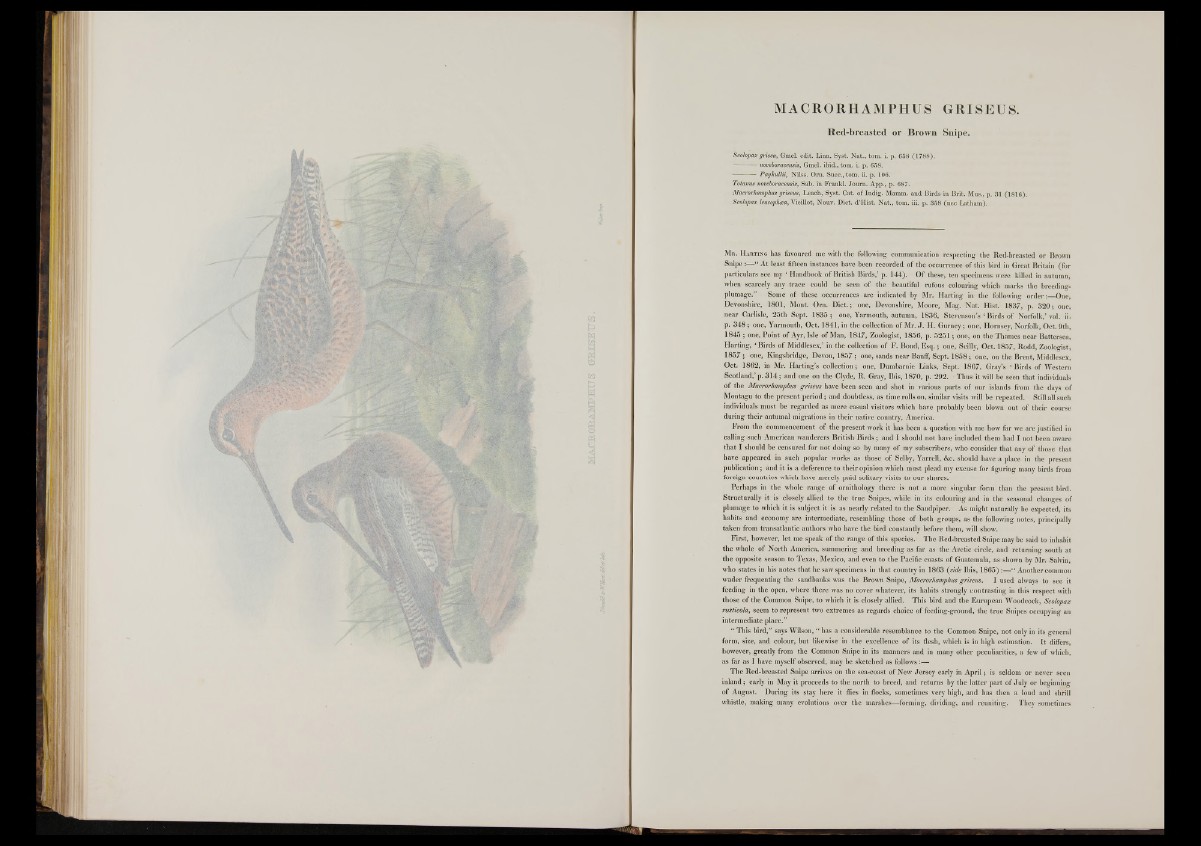
MACRORHAMPHUS GRISEUS.
Red-breasted or Brown Snipe.
Scolopax grisea, Gmel. edit. Linn. Syst. Nat., tom. i. p. 658 (1788).
noveboracensis, Gmel. ibid., tom. i. p. 658.
---------- Payhullii, Nilss. Orn. Suec., tom. ii. p. 106.
Totanus noveboracensis, Sab. in Frankl. Joum. App., p. 687.
Macrorhamphus griseus, Leach, Syst. Cat. of Indig. Mamm. and Birds in Brit. Mus., p. 31 (1816).
Scolopax leucophaa, Vieillot, Nouv. Diet. d’Hist. Nat., tom. iii. p. 358 (nec Latham).
M r. H a r t in g has favoured me with the following communication respecting the Red-breasted or Brown
Snipe :—■“ At least fifteen instances have been recorded o f the occurrence of this bird in Great Britain (for
particulars see my ‘ Handbook o f British Birds,’ p. 144). O f these, ten specimens were killed in autumn,
when scarcely any trace could be seen o f the beautiful rufous colouring which marks the breeding-
plumage.” Some of these occurrences are indicated by Mr. Harting in the following o rd er:—One,
Devonshire, 1801, Mont. Orn. Die t.; one, Devonshire, Moore, Mag. Nat. Hist. 1837, p. 3 2 0 ; one,
near Carlisle, 25th Sept. 1835 ; one, Yarmouth, autumn, 1836, Stevenson’s ‘ B irds of Norfolk,’ vol. ii.
p. 3 4 8 ; one, Yarmouth, Oct. 1841, in the collection of Mr. J . H. Gurney; one, Hornsey, Norfolk, Oct. 9th,
1845 ; one, Point o f Ayr, Isle of Man, 1847, Zoologist, 1856, p. 5 2 5 1 ; one, on the Thames near Battersea,
Harting, ‘Birds o f Middlesex,’ in the collection of F. Bond, E s q .; one, Scilly, Oct. 1857, Rodd, Zoologist,
1 8 5 7 ; one, Kingsbridge, Devon, 1 857; one, sands near Banff, Sept. 1858; one, on the Brent, Middlesex,
Oct. 1862, in Mr. Harting’s collection; one, Dumbarnie Links, Sept. 1867, Gray’s ‘ Birds o f Western
Scotland,’ p. 3 1 4 ; and one on the Clyde, R. Gray, Ibis, 1870, p. 292. Thus it will be seen that individuals
of the Macrorhamphus griseus have been seen and shot in various parts of our islands from the days of
Montagu to the present perio d ; and doubtless, as time rolls on, similar visits will be repeated. Still all such
individuals must be regarded as mere casual visitors which have probably been blown out of their course
during their autumal migrations in their native country, America.
From the commencement o f the present work it has been a question with me how far we are justified in
calling such American wanderers British B ird s ; and I should not have included them had I not been aware
that I should be censured for not doing so by many o f my subscribers, who consider that any o f those that
have appeared in such popular works as those o f Selby, Yarrell, &c. should have a place in the present
publication; and it is a deference to their opinion which must plead my excuse for figuring many birds from
foreign countries which have merely paid solitary visits to our shores.
Perhaps in the whole range of ornithology there is not a more singular form than the present bird.
Structurally it is closely allied to the true Snipes, while in its colouring and in the seasonal changes of
plumage to which it is subject it is as nearly related to the Sandpiper. As might naturally be expected, its
habits and economy are intermediate, resembling those o f both groups, as the following notes, principally
taken from transatlantic authors who have the bird constantly before them, will show.
First, however, let me speak o f the range o f this species. The Red-breasted Snipe may be said to inhabit
the whole o f North America, summering and breeding as far as the Arctic circle, and returning south at
the opposite season to Texas, Mexico, and even to the Pacific coasts of Guatemala, as shown by Mr. Salvin,
who states in his notes th at he saw specimens in that country in 1863 (vide Ibis, 1865) :— “ A nother common
wader frequenting the sandbanks was the Brown Snipe, Macrorhamphus griseus. I used always to see it
feeding in the open, where there was no cover whatever, its habits strongly contrasting in this respect with
those o f the Common Snipe, to which it is closely allied. This bird and the European Woodcock, Scolopax
rusticóla, seem to represent two extremes as regards choice of feeding-ground, the true Snipes occupying an
intermediate place.”
“ This bird,” says Wilson, “ has a considerable resemblance to the Common Snipe, not only in its general
form, size, and colour, but likewise in the excellence o f its flesh, which is in high estimation. It differs,
however, greatly from the Common Snipe in its manners and in many other peculiarities, a few o f which,
as far as I have myself observed, may be sketched as follows :—
The Red-breasted Snipe arrives on the sea-coast o f New Jersey early in A p ril; is seldom o r never seen
inland; early in May it proceeds to the north to breed, and returns by the latter p art o f July or beginning
of August. During its stay here it flies in flocks, sometimes very high, and has then a loud and shrill
whistle, making many evolutions over the marshes—forming, dividing, and reuniting. They sometimes